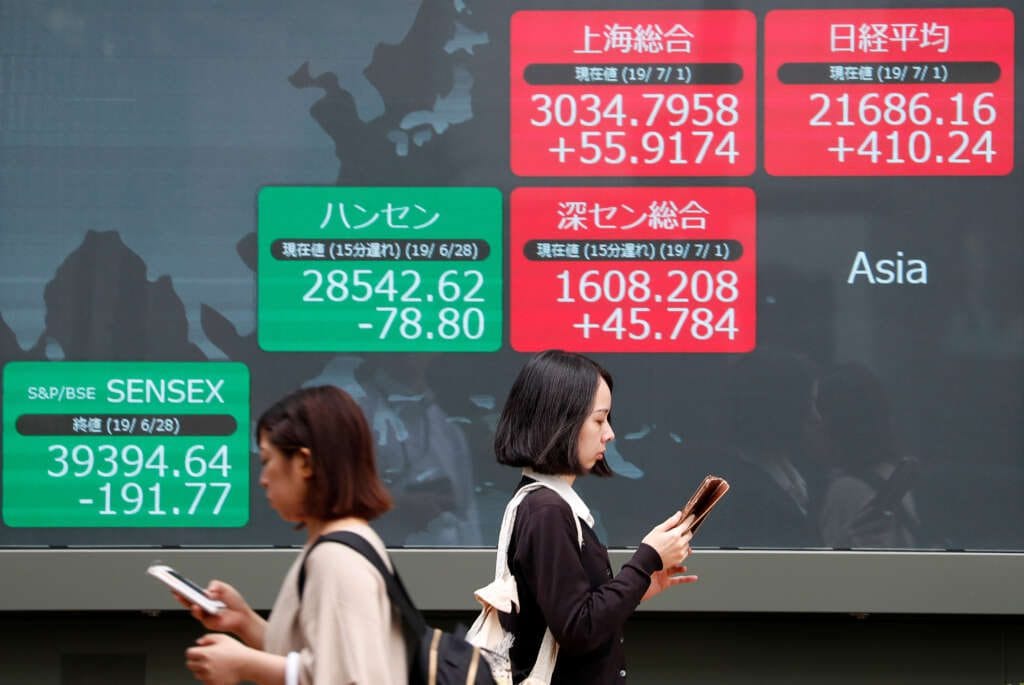
By Wayne Cole
SYDNEY (Reuters) – Asian shares recovered from early losses on Tuesday as investors weighed the near-term costs of the coronavirus infections in China against the longer-term benefits of a complete reopening of the world’s second-largest economy.
MSCI’s broadest index of Asia-Pacific shares outside Japan edged up 0.5%, having been down more than 1.0% in choppy early trading.
Liquidity was lacking as Japanese markets were shut for a holiday, making for some choppy moves. Nikkei futures were trading at 25,750 compared with the last close for the cash index of 26,094.
Investors were encouraged by a 1.3% bounce in the Hang Seng, which had been off more than 2% at one stage, while Chinese blue chips inched up 0.2%.
A batch of surveys had showed China’s factory activity shrank at the sharpest pace in nearly three years as COVID-19 infections swept through production lines.
“China is entering the most dangerous weeks of the pandemic,” warned analysts at Capital Economics.
“The authorities are making almost no efforts now to slow the spread of infections and, with the migration ahead of Lunar New Year getting started, any parts of the country not currently in a major COVID wave will be soon.”
Mobility data suggested that economic activity was depressed nationwide and would likely remain so until the infection wave began to subside, they added.
Wall Street was in a guarded mood, with S&P 500 futures and Nasdaq futures up 0.1%. EUROSTOXX 50 futures fell 0.6% and FTSE futures 0.1%.
Data on U.S. payrolls this week are expected to show the labour market remains tight, while EU consumer prices could show some slowdown in inflation as energy prices ease.
“Energy base effects will bring about a sizeable reduction in inflation in the major economies in 2023 but stickiness in core components, much of this stemming from tight labour markets, will prevent an early dovish policy ‘pivot’ by central banks,” analysts at NatWest Markets wrote in a note.
They expect interest rates to top out at 5% in the United States, 2.25% in the EU and 4.5% in Britain and to stay there for the entire year. Markets, on the other hand, are pricing in rate cuts for late 2023, with Fed fund futures implying a range of 4.25 to 4.5% by December.
Minutes of the Federal Reserve’s December meeting due this week will likely show many members saw risks that interest rates would need to go higher for longer, but investors will be attuned to any talk of pausing, given how far rates have already risen.
While markets have for a while priced in an eventual U.S. easing, they were badly wrong-footed by the Bank of Japan’s shock upward shift in its ceiling for bond yields.
The BOJ is now considering raising its inflation forecasts in January to show price growth close to its 2% target in fiscal 2023 and 2024, according to the Nikkei.
Such a move at its next policy meeting on Jan. 17-18 would only add to speculation of an end to ultra-loose policy, which has essentially acted as a floor for bond yields globally.
Japanese 10-year yields have steadied just short of the new 0.5% ceiling, but only because the BOJ stepped in last week with unlimited buying operations.
The policy shift boosted the yen across the board, with the dollar losing 5% in December and the euro 2.3%.
The trend continued on Tuesday as the dollar slid 0.9% to a six-month low of 129.52 yen, having breached major chart support at 130.40. The euro fell to its lowest in three months at 138.26 yen.
The euro was steady on the dollar at $1.0679, after meeting resistance around $1.0715, while the dollar index was holding at 103.480.
In commodity markets, gold made a fresh six-month top of $1,842.99 an ounce. [GOL/]
Worries about the state of global demand saw oil prices lower. Brent lost 41 cents to $85.50 a barrel, while U.S. crude fell 33 cents to $79.3 per barrel.
(Reporting by Wayne Cole; Editing by Bradley Perrett and Sam Holmes)


